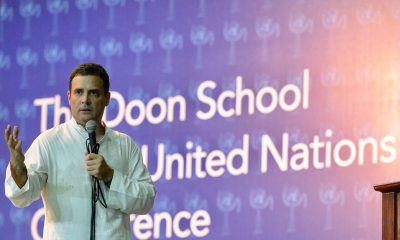India
Indian String of Pearls "Unstringing" Chinese String of Pearls Theory
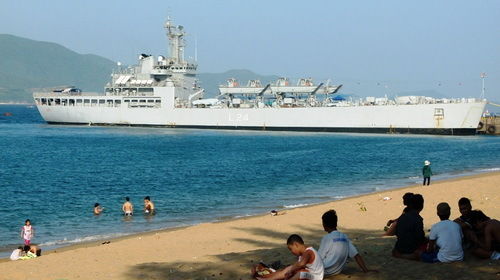 Month of May was full of geopolitical developments and changes in one of the most nuclear armed hostile region of the world, the CIP band (China-India-Pakistan). The new premier of China went to India on his first ever foreign visit and then to meet the new leadership of their ally, Pakistan. In the meantime Afghan President came to India in his unofficial low profile meeting, but making solid developments. Indian Prime Minister in the hope of surviving in the next election met with Japanese and Thai leadership signing various economic and strategic pacts. All this happened in a short period of time and quite related to each other.
Month of May was full of geopolitical developments and changes in one of the most nuclear armed hostile region of the world, the CIP band (China-India-Pakistan). The new premier of China went to India on his first ever foreign visit and then to meet the new leadership of their ally, Pakistan. In the meantime Afghan President came to India in his unofficial low profile meeting, but making solid developments. Indian Prime Minister in the hope of surviving in the next election met with Japanese and Thai leadership signing various economic and strategic pacts. All this happened in a short period of time and quite related to each other.
China renewed the border dispute with India by entering 19 Km deep inside Indian territory in Laddakh and setting up temporary bases. With this, People’s Liberation Army of China has made it clear that with the new premier of China is not going to change its stance on the border issue between the two countries. China’s aggressiveness is as a result of India’s passiveness specially on the border issues with China. A number of times India just ignores Chinese intrusion just to avoid any major or minor conflict with the giant dragon. India’s behaviour like a “wet cat” encourages China to suppress India with its power. The border dispute was resolved on the assurance from India that its army will not patrol on its own territory of that region and will treat it as a disputed territory. The government in India later cheered that they have resolved the border dispute peacefully and patiently. Such a wonderful achievement, really!!
The term string of pearls (Read More: Chinese String of Pearls Theory) theory is mainly used for China, how it is surrounding India and other south east Asian nations with its presence forming a string of pearls. String of pearls may or may not be a threat for the countries being surrounded, but surely a warning that at the time of need China may anytime use its developed infrastructure against them.
Unlike India, Vietnam and Philippines have been more assertive in claiming their sovereignty in the disputed South China Sea. Almost an year ago, officials of Philippine maritime attempted to arrest Chinese fishermen in waters off Scarborough Shoal, claimed by the Philippines as within its Exclusive Economic Zone. This is something which India could have done with the Chinese soldiers who had entered inside the Indian territory. India had full rights to do so and then could have opened diplomatic channels for returning the soldiers with a warning.
The South China Sea area is crossed by more than half the world’s total trade and has an estimated vast energy and mineral reserves completely claimed by China and in part by neighbouring nations: Vietnam, Malaysia and the Philippines. One of the main reason of the tension is fishing rights of Philippines, Vietnam, Malaysia and Brunei in their own waters. China stops fishing near its shores from mid-May until August to facilitate nurturing of fishes in the water. This makes Chinese fishermen, guarded by naval vessels, head to the waters claimed by neighbouring countries without even recognizing their territorial claims, China considers almost all of the South China sea as its territorial water.
On May 10, the Philippines claimed China intruded inside its 370 Km exclusive economic zone with a military frigate, two surveillance ships and some fishing boats around Second Thomas Shoal, days after the incident, the Philippines launched a diplomatic protest which did not stop China as after ten days on May 20, Vietnam filed a diplomatic protest saying one of its ships was rammed by a Chinese vessel on May 20 in its water.
China simply ignores the territorial claims made by its neighbours in the South China Sea as it is assertive that South China sea is Chinese territory and there is no way China would hold a dialogue with the neighbours on the territorial issue. According to Ni Lexiong, professor of international military affairs and diplomacy at the Shanghai University of Political Science and Law, China’s neighbors are making claims in the South China Sea that are “not reasonable” because they want access to oil resources.
India’s opinion on Chinese string of pearls theory is a bit disappointing to China’s south east Asian neighbours who are in need of non regional powers to mediate for bringing peace and stability in the region. According to India, Chinese economy is dependent on its large number of imports and exports which passes through Persian Gulf and Straight of Malacca, hence having security setup to secure its economy is legitimate and India should not worry.
“Unstringing” Chinese String of Pearls Theory
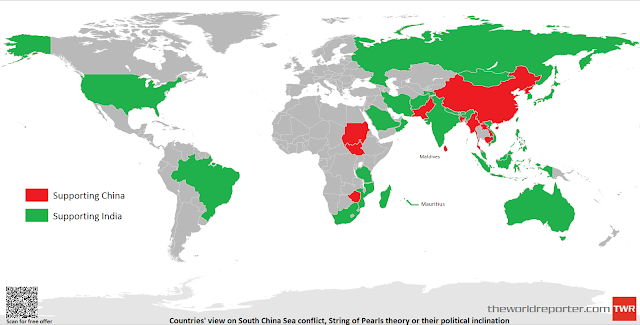 |
| View of various countries on South China Sea conflict, String of pearls theory or their political inclination |
India has quietly made way for its interests in the island nations and African nations in Indian Ocean Region, which includes Mauritius, Maldives, Seychelles and Madagascar and the countries of South Africa, Tanzania and Mozambique with a very agile foreign policy, economic compensations like the double taxation exemption with Mauritius, and military aid.
Indian Navy maintains a robust hydrographic arm, with eight sophisticated survey ships, a number of survey aircrafts, and state of the art facilities in Dehradun and Goa. The well equipped surveying arm of the Indian Navy has made several successes in undertaking various survey assignments for countries like Oman, Saudi Arabia and island nations in the Indian Ocean making a positive strategic footprints that would certainly irk China. India has in fact gained ship berthing rights in Oman which is a strategic location for the fight against piracy. The port also allows the Indian Navy to monitor the SLOCs of Hormuz and Aden.
India has signed an MoU with Mozambique that will provide the African nation Indian piracy patrols. Going a further step, in a 2007 report, which has not been denied by the government, it was reported that India has setup a listening post in the African island nation of Madagascar.
Forums like IOR-ARC (Indian Ocean Rim – Arrangement for Regional Cooperation) and IBSA (India-Brasil-South Africa) have been formed for better commercial, energy and resources link with Africa. Assertive India not only brought Mauritius, Mozambique and Madagascar to back India’s move to block Pakistan’s membership in IOR-ARC, but also managed to block China’s access to IBSA.
According to an unconfirmed report, India signed an agreement on Defence Cooperation in 2001 with Mongolia stationing radar systems able to monitor Chinese missile tests. Defence cooperation also included holding bilateral military exercises and discussion on having an airbase which has not yet been successful.
India on the other hand has developed strong military relationship with Maldives, which includes basing two helicopters permanently in the island nation to enhance its surveillance capability. India will setup 26 radars in Maldives along its entire coastline for seamless coverage of approaching vessels and aircraft. This radar chain will be interlinked with the Indian radar chain with a central control room in India’s Coastal Command.
African island nation of Mauritius enjoys deeper relations with India. India had setup the Mauritius Coast Guard in the 70s and the island nation gone even further to lease two islands to India allowing it to use it “as per its benefit”. Coming back to the land, India maintains Farkhor air base and has been involved in renovating Ayni air base both in Tajikistan minutes away from Pakistan Occupied Kashmir and China occupied Kashmir. (Read Both the Stories: India Expanding Its Strategic Presence in Other Countries).
Indian Iron Curtain (String of Pearls) on Chinese Backyard
India and Vietnam has signed several defence agreement which includes selling of state of the art, world’s fastest supersonic cruise missile, Brahmos. Vietnam has also provided basing rights to Indian Navy on its port of Nha Trang on a western shore of the South China Sea. Russia, which has been recently partnering with China in almost all the global events surprised China with its move to provide six Varshavyanka-class submarines to Vietnam which has enhanced anti-ship and anti-submarine warfare capabilities to perform in shallow waters, a perfect card to play in the South China sea. Russia whose superpower attitude has been on decline since 1991 is expecting to enter South China sea conflict in its own way when people have started analyzing that Russia has lost to China in its race to become the next superpower (What’s your opinion on this?).
In 2011, India’s state-run explorer, OVL signed a three-year deal with PetroVietnam for developing long-term cooperation in the oil sector, accepting Vietnam’s offer of exploration in the South China Sea making China protest against this move.
Vietnam, which had a tough history with United States has invited US presence in the region giving the signal that for regional peace and stability Vietnam doesn’t mind participation of non regional nations. To solidify its relations further with United States, Vietnam is expected to request the US government for the sale of Lockheed Martin P-3 Orion maritime patrol aircraft, a senior company official told IHS Jane’s. This makes clear that Vietnam is trying India’s long trusted policy of forming good relations with both the United States and Russia. Vietnam’s attitude shows the potential, which it has, to become the regional power of south east Asia.
In the meantime, US Defense Secretary Chuck Hagel has assured Asian nations that despite their sharp cuts in defence budgets, the Pentagon will continue to shift its military focus to the Asia Pacific region.
In 2009, India contributed $1.2 million and advanced $774,000 to the TTEG (Tripartite Technical Experts Group). India volunteered to survey wrecks in the Malacca Straits which approved by the TTEG, further irking the Chinese.
Responding to the recent visit of Indian Prime Minister Manmohan Singh to Japan discussing maritime security cooperation, Chinese media has raised concerns that Japan is trying to encircle China with the help of military and economic cooperation with India.
While India easily bows down to China making compromises on its own territories, India is seen very assertive and aggressive in its policy of containing China in the international soil and waters. Leadership of both the nations often meet with shaking hands and smiles on their face signing more trade agreements and contracts and hoping for better cooperation in the future, but behind their smiley face both the nations know what they are doing and what is needed to be done.
India
Government Changing Syllabus to Include Sikh History in India
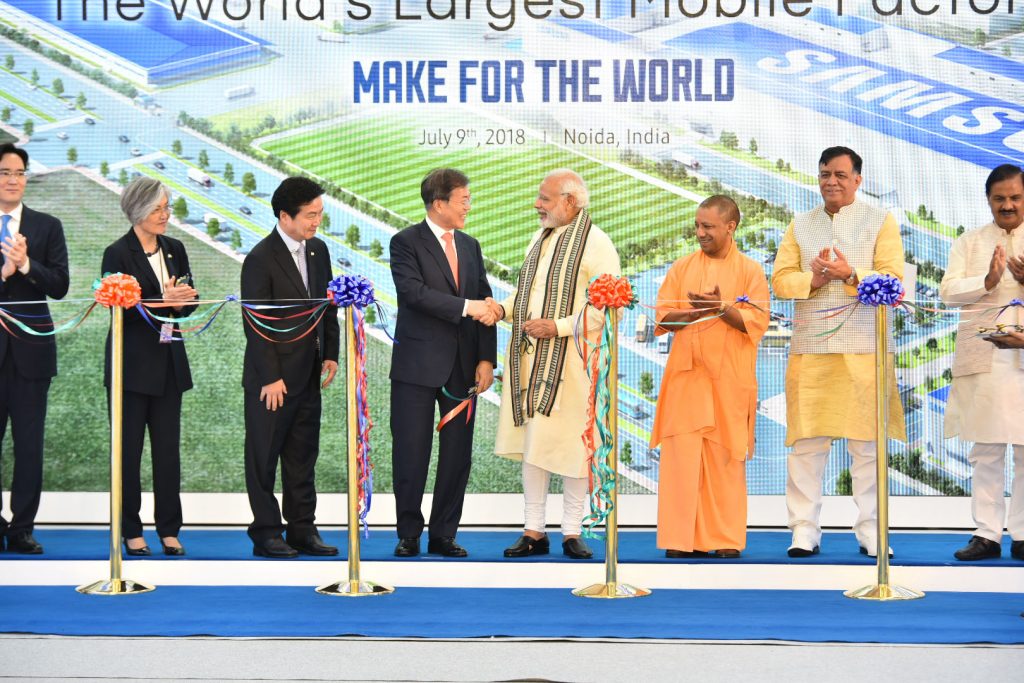
Chief Minister of Uttar Pradesh, most populous state in India, has announced inclusion of Sikh history in the state syllabus. Students of all schools under UP State Board will see the new chapters. The announcement came when Chief Minister Yogi Adityanath (BJP) was observing Sahibzada Diwas.
Why do we Observe Sahibzada Diwas?
Sahibzada Diwas marks the martyrdom of four ‘sahibzada’ (or sons) of Guru Gobind Singh (10th Sikh Guru) and his mother Mata Gujri. In the year 1705, Mughal Emperor Aurangzeb had ordered torturing of youngest sons of Guru Gobind Singh aged 5 and 8. He later executed the little sons by burying them alive into a wall. The reason for this act was that they refused to convert to Islam. Soon after this event Guru Gobind Singh’s mother, Mata Gujri also martyred her life under Aurangzeb’s captivity. The cause of her death is still unclear. Guru Gobind Singh’s other two sons martyred their life in the Battle of Chamkaur Sahib. Thus the 10th Sikh Guru, Guru Gobind Singh had lost his whole family by 27th December. This is an important event in the Sikh history in India and UP Government is finally keen on observing Sahibzada Diwas every year.
Why UP Government is Changing the Syllabus?
Soon after the independence of India in 1947, the school education came under tight grip of far left and communists. Most of the Indian history in the recent past has been written by Romila Thapar and Irfan Habib. They have close ties with left wing ideology and Irfan Habib has delcared himself as Marxist. They wrote history text books by either phasing out sections of Indian history or diluting certain events. The motivation to soft alter the history has been to propagate left-wing/communist ideology. Historian Koenraad Elst once highlighted that Romila Thapar is comfortable neither in Sanskrit nor in Farsi language. The knowledge of these two languages is a must to understand India’s history.
In the recent years, various public opinions have gained momentum to rewrite Indian text books to include more content on Indian rulers and native ideas. Currently, Indian text books mainly teaches about foreign rulers of India such as Mughals and British.
With this announcement of inclusion of Sikh history in history text books, the government is bringing historical facts in mainstream.
27th December as Real Children’s Day
Chief Minister Yogi Adityanath has also reached out to the Education Minister to declare Sahibzada Diwas as Children’s day. He further added that “The history of Sikh gurus will be a part of the syllabus. Apart from this, we should observe December 27 every year as Sahibzada Diwas in all schools. Today is the day to pay gratitude to the sons of the Guru and mother who martyred their lives for the motherland, country and religion.” Yogi Adityanath also said that “No society can move ahead if it forgets history. The Sikh society is known for its hard work. The Sikh gurus sacrificed their lives to defend the Hindu religion. The country will always remember this.”
Yogi Adityanath added that learning about the sacrifices by Sikh Gurus would inspire future generations to dedicate themselves into nation-building. He emphasized that we should make future generations realize that India and Indian culture was safe because of sacrifices of Sikhs.
What Should We Do On Sahibzada Diwas?
Sahibzada Diwas should be an important day for every Indian regardless of their region, culture or religion. On this day, we are in the Holiday mood as it falls right between Christmas and New Year’s eve. However, we should remember that a Guru and his entire family sacrificed their life for the well being of India and the idea of India.
On this day we can fast, do sewa (service), visit a nearby Gurudwara and sleep on the floor at night.
China
Nepal Hindu Rashtra: Time to Wrap Up Communism?
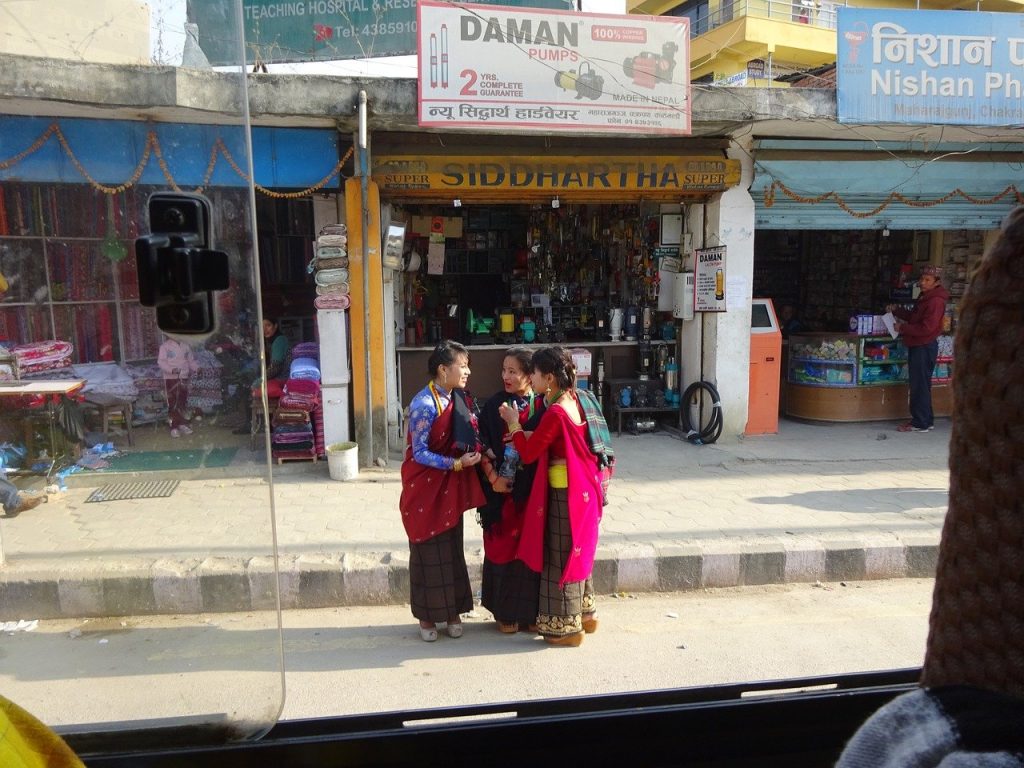
Nepal abolished the Constitutional Monarchy in May 2008 and declared itself as a Federal Democratic Republic. There was a new hope in Nepal as it was becoming world’s newest democracy even though it had dissolved the Hindu Rashtra. However, the democracy in Nepal immediately got into the tight grips of leftists and communists backed by China. It has been almost 12 years since monarchy was abolished in Nepal. Interestingly, the Himalayan country has already seen 11 Prime Ministers in this period. Thus, leaving the Nepalese people still yearning for good and stable governance.
Re-establish Hindu Rashtra
As the political instability is growing in Nepal, people are demonstrating concerns about the future of the country. In fact, Nepalese citizens are unhappy with frequent interference by China and India influencing its unstable communist regime. More voices are now growing in support of reinstating the Monarchy and declaring Nepal as world’s only Hindu Rashtra (which by default offers full religious freedom to other religious minorities as per Hindutva concept of Sarva Dharma Sama Bhava – all paths lead to one).
Former Deputy Prime Minister of Nepal, Kamal Thapa said that if political parties do not recognize the seriousness of reinstating the monarchy, then the country will head for a period of darkness. “Recently, we’ve had high-ranking officials from India and China come to Nepal to try and solve problems within the ruling party,” he said. “We cannot let others dictate what we want to do.”
Communist Party All Set to Suppress Protests, By Force
Kamal Thapa has firmly demanded an all party meet to discuss reinstating of monarchy. Throughout the month of December, 2020 Nepal has seen anti communism protests across the country in support of reinstating the monarchy and Hindu Rashtra. Most importantly, the demand has become a nationwide mass people’s movement. So much so that the communist regime had to send a directive to 77 districts in 7 provinces. The directive suggests suppressing the protests by force. Nevertheless, Rashtriya Prajatantra Party and other royalist groups have ignored this threat from the communist regime. Protester groups have pledged to strengthen the protest in the coming weeks.
Nepal: Demonstration held in capital Kathmandu, demanding restoration of monarchy in the country. pic.twitter.com/TFjmKu9U9Z
— ANI (@ANI) December 5, 2020
Role of China – Hope for Communism in Nepal
China’s ambassador to Nepal is known to have very close relationship with Nepalese Communist regime. In fact, She has been super effective in tilting Nepal’s posture towards its ideological partner, China. One of her greatest achievements in 2020 was artificially manufacturing a border conflict between Nepal and India. Consequently, souring relations between the two Hindu majority nations. In addition, she managed to silence Nepal’s communist government after China took one of Nepal’s border villages under its control. However, recent political turmoil in Nepal and a renewed demand for reinstating of Hindu Monarchy is showing that the situation is now out of Chinese hands
Role of India
Year 2020, was not a good year for India and Nepal relations. India was busy in controlling domestic Covid cases. On the other hand, China had launched an invasive campaign into Indian territory. In addition, India is always busy with Pakistan on its western borders. However, the surprise came to India when China was almost successful in creating a new border tension between India and Nepal.
Those who do not know about Indian government should note that the current ruling party in India finds itself ideologically opposite to communism. This further creates differences between the two countries.
Communist party in Nepal has blamed India for supporting the ongoing anti communism protests in Nepal. However, former advisor to Nepal’s PM has suggested there is no proof that India is fueling pro Monarchy, anti communism demand in Nepal.
Nevertheless, There are certain influencers in India who have, in their personal capacity, expressed support for reinstating the Hindu monarchy. Yogi Adityanath, who is the Chief Minister of an Indian state bordering Nepal, said in 2015 that Nepal should declare itself a Hindu Monarchy. Readers should note that in 2015 Yogi Adityanath was not the Chief Minister yet. However, today he is not only popular in south of Nepal, his popularity is growing in Nepal as well.
Will The World See the first Hindu Rashtra?
It is difficult to answer this question at this moment. However, Nepalese communist government could not resolve the political instability and in December 2020 Nepalese government dissolved the parliament. Nepal will see next elections in April – May 2021. Hopefully, the world will see Nepal’s 12th Prime Minister in 13 years or may be a Hindu King? Royalists and protester groups have expressed confidence in winning next elections. We have our eyes on Nepal for updates.
India
Humanity Endures During Coronavirus Pandemic

Photo by Press Information Bureau, Government of India
The world changed exponentially since the pandemic broke out. We changed too. Emotions are running high. We have learnt to take one day at a time and have stopped expecting changes to happen overnight.
“COVID19 is menacing the whole of humanity – and so the whole of humanity must fight back”
A clarion call from United Nations Secretary-General António Guterres is a call to unity and solidarity. Already plagued by natural/manmade disasters and wars, many countries seem to bite the dust for want of resources in the fight against the virus. Warning each other against complacency is appreciable but never a blame game to cover up a dysfunctional response. Not all update themselves on the governments, new economic policies and R&D on Covid vaccine. Many we come across seem to be making wise individual choices. No matter how badly the tiers of government fail us, there will always be thousands of people working to make things better. Besides, finding reasons and faults on policies for the spread doesn’t help. A virulent strain of flu had managed to spread within a few months to the remotest corners of the world infecting half a billion people – more than a quarter of the human species in 1918 long before the current age of globalization.
Separating, alienating and forswearing the endless moments of contact that knit society together thrust us into frightening new realities. The good is still there. Social distancing is nothing but taking a step back to literally give breathing space to others. Going by news & views, we understand that amid concerns of rising numbers of positive cases in frustrating circumstances, acts of kindness and solidarity are burgeoning. Yes, it’s been extremely sad and sobering to watch this all unfold, but watching people share resources and supporting one another in every conceivable way has made us feel more connected to our local communities. Whether singing a song together out on balconies, getting groceries for the elderly or calling a friend to alleviate anxiety and fear, each one I know play a part and take comfort in a sense of togetherness. We are steadily aware of our limitations yet don’t hesitate to free our wells of compassion. Do we think twice and thrice to make an online contribution to save the lives of people we don’t know and will never know!
Sadly, it has taken an invisible virus to help us belive once again that we are strongest only when we have the welfare of others in our mind. Halfway through quarantine and self-isolation a phone call, a kind word, an opportunity to reach out, a breeze, bird calls, one good news and loss of a loved one, we are hit with the necessary humility and awe we ought to feel and appreciate just how beautiful our world is and precious life is.
Post pandemic recovery will be better and bigger if life goes on with this beautiful idea, of humility, inwardness – as an ethical relationship, for the sake of others. For better or for worse, we have learnt that one can’t be an island unto himself. Lives are intertwined and are bound together. We, humans produce more rubbish than any other species. The growth in the human population is part of the explanation, but cannot account for all of the extra rubbish, a result of haste and greed both which almost skinned humans of humanity.
Unity among countries must ensure that all countries are equipped to trace, isolate and treat people infected by COVID-19. Only a global effort can avoid the collapse of any country’s medical system. Sanctions that affect health care should never be imposed. Development in one part of the world should not rob another country of it’s resources. Humanity gains the upper hand over invisible predators through the sharing of reliable scientific information, global solidarity, vaccinations, antibiotics, improved hygiene and a much better medical infrastructure. Today,it doesn’t take too much to figure out that global sharing and caring is the best defense. The Jing Si aphorism, “Good actions require everyone’s cooperation. So let’s not cling to personal biases” holds good for all times.
Stories of good samaritans are aplenty. To know humanity is still alive and kicking and is at it’s best when united assures us that we’ll come out of this “abnormal” time with a new normal. In their own unique ways, humans respond to protect life and health and ensure respect for fellow beings. ‘single-nucleotide polymorphisms’ are no joke. From handing over meals, survial kits, medicines, home made masks to calling on an old couple across the street, everything is humanity in action and it is the power of this humanity – humane behaviour towards other humans – that we seek to celebrate, improve and increase, especially during crucial times. Remember “A person with a generous heart and compassion for all beings leads the most blessed life”.
With thousands of migrant workers taking it on their chin, vehicles filled with food and ration along highways reach the needy and stranded and canteens serve free food. Rays of sunshine! We see through hypocrisy and deceptions, hear excuses for inefficiency, inadequacy and inflexibility and within the tumult and uncertainty we are doing much, much better in life than we thought we can. Quietly. Kindly. Gently. Being able to spare a part of us to help someone live is worth being thankful for. ” Giving with an expectation for return brings misery”. May we give generously, but don’t guilt ourselves if we can’t. If we have nothing left to spare, let’s go slow and kind.
The world is being taught a lesson, the harder way. This lesson is not about rich and powerful versus poor and powerless but about leadership that treasure the common wealth and common good, above private greed and profit and above protecting the privileges of a handful elites.
None of us are actually going anywhere. Might as well stay. The conclusion we draw from this crisis is that all humans matter equally, that we need to give a hand, raise one another, flourish or perish together- no matter what our limitations are, we’re capable of a great deal. This virus backlash is nothing short of a fleeting lesson to all leaders about how sane, humane societies should function all the time. Those who regard themselves as wonderfully favored of leadership, power and pelf are called to do great things. Anything that constantly arise to cause conflicts or disunion must be questioned, criticized, denounced and judged.
Be it a forced contemplation of our mortality or a sudden urge of self denial or an awareness of the passage of time and life, this screeching halt is proof that humans are designed to be more productive when connected, even in isolation. So, not all hope is lost. The time has come when we must know for ourselves why we believe in humanity as we do.
“Do something good for somebody today; the people who are trying to make the world worst aren’t taking days off.”
Gestures to honor humanity are varied, aplenty. A flypast in India is a cruel joke on the already tumbling down economy and on the selfless humanitarians who spare nothing to reach out. We can only wish the trail of showered petals, if showered will guide the departing victims of COVID19. Flying past/over ground realities is a highly irresponsible act of governments. Also, a misuse and mismanagement of meagre resources.
Was it a premonition that urged saint Thiruvalluvar, celebrated Tamil poet and philosopher to get on with kural 578 which when translated into English goes as
” The world is theirs (Kings) who are able to show kindness, without injury to their affairs, (administration of Justice).
-

 Technology12 months ago
Technology12 months agoHow Virtual Fly Elevates the World of Flight Simulators
-

 Travel12 months ago
Travel12 months agoImmerse Yourself in Nature: Explore Forest Bathing with a New Guidebook
-

 Europe12 months ago
Europe12 months agoBarcelona and Athens: cities that will leave an everlasting impression
-

 Health12 months ago
Health12 months agoExperience in clinical quality: What is it, and why is it important?
-

 Travel8 months ago
Travel8 months agoEnjoy a luxury holiday in Zanzibar
-

 Business8 months ago
Business8 months agoServiceNow Development Consultancy: Business Process Automation as Disruptive Technology
-

 Culture and Lifestyle8 months ago
Culture and Lifestyle8 months agoDo you want to surprise a special someone?
-

 Environment8 months ago
Environment8 months agoThe Future of Fashion: The Rise of Eco-Conscious Brands in the Luxury Market






